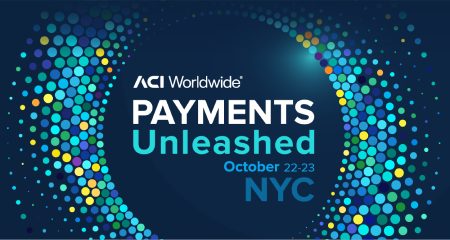- Solutions
- Banking
-
- ACI ConneticUnified cloud payments platform
- AcquiringDigital acceptance, merchant management
- IssuingDigital payments and accounts issuing
- Fraud managementReal-time enterprise fraud management
- RTGS / Wires and cross-borderMulti-bank, multi-currency processing
- Real-time, instant paymentsComplete real-time payments processing
- ATMsSelf-service, omnichannel digital experience
- Central infrastructureInnovative real-time payment infrastructure
- NEW Payment Hubs: Why Banks Must Move Forward With Urgency
-
- Merchant payments
- ACI Payments Orchestration PlatformEnable customer journeys across commerce channels, accept payments, prevent fraud and optimize your payments journey
- In-storeDynamic, modern in-store payments
- eCommerceOnline and mobile payments
- Alternative payment methodsGive more ways to pay
- Value-added servicesEngagement, optimization and reporting
- Fraud managementEnd-to-end fraud orchestration
- Risk, security, and complianceAchieve and maintain compliance
- NEW Datos names ACI Worldwide best-in-class in payments orchestration
- Industries we serve
- Billing and bill payments
- ACI SpeedpayDrive customer satisfaction with the widest range of bill pay options in the industry.
- Bill payment APIs and SDKsOutsource bill payment processing
- Fraud managementAI-based fraud orchestration technology
- Alternative payment methodsGive more ways to pay
- Loan servicingPreferred loan payment options
- Treasury managementStreamline and integrate your back office
- Automated debt collectionImprove your collections process
- Digital walletsManage digital cards and payments
- PCI compliance and securityAchieve and maintain PCI compliance
- Industries We Serve
- Fraud management and payments intelligence
- Fraud managementFraud solutions to minimize risk and prevent fraud
- Fraud management for bankingEnterprise-wide fraud prevention
- Anti-money launderingStay ahead of money-laundering schemes
- Robotic process automationAutomate payment processing operations
- Fraud management in the cloudProtecting your business in the cloud
- Fraud management for merchantsProtect payments from end to end
- ChargebacksPrevent chargebacks before they happen
- SCA complianceAchieve and maintain SCA compliance
- Digital identity solutionsConfirm identities with behavioral analytics
- NEW Scamscope fraud report: APP scam trends from around the globe
Company CustomersPartners
CustomersPartners
Home
On this page
Payment tokens are utilized by processors, gateways, acquirers, networks, and mobile devices. How can merchants effectively manage them all?
This article explains why merchants need a token strategy. If you need a primer or refresher on the topic, please read Network Tokenization: The Complete Guide for Merchants.
Tokens are everywhere
I recently read an article in Digital Transactions titled “Billions of Tokens,” which discusses significant tokenization milestones achieved by Visa and Mastercard. Visa’s network token volume is increasing by 40% annually, reaching an impressive 12.6 billion tokens. Similarly, Mastercard now processes approximately 1 billion network tokens each week.
In recent years, tokenization has become increasingly prevalent. The article suggests that credit card payments may soon be fully tokenized. Since PCI DSS requires storing primary account numbers (PAN) in a manner that cannot be reverse-engineered, all participants in the payments ecosystem might utilize a payment token (surrogate value for PAN) during transactions.
Why do merchants need a tokenization strategy?
Processors, gateways, acquirers, networks, and mobile devices utilize payment tokens. So how do merchants manage them all? Merchants need a tokenization strategy or at least to standardize on a single source.
Merchants who utilize a simplified payment processing approach with a single provider should ideally use the token provided by their processor, acquirer, or gateway for each transaction. Merchants need to ensure two key aspects: the tokens should be format-preserving (maintaining 16 digits, with the additional benefit of having the last four digits unmasked), and the processor should be able to associate these tokens with network tokens. This association can enhance acceptance rates, reduce costs, and mitigate fraud.
The primary challenge with this strategy is vendor lock-in, as these tokens will proliferate throughout the merchant’s connected ecosystem, if they operate omnichannel services, maintain a loyalty program, or have closely tied partners.
Given that a token’s greatest value lies in its function as unique secure shareable database keys, merchants must share them effectively.
Merchants using multiple acquirers may need to manage various tokens for the same customer/PAN, ensuring accurate identification of the originating acquirer. This complexity highlights the need for a strong tokenization strategy.
One token to bind them all
The title of this blog, “One token to bind them all,” refers to the concept of an omni-token. This omni-token is a single representation of a customer’s credit card that can be associated with any other token the merchant receives back or needs to utilize. Unlike the ring in Tolkien’s Lord of the Rings trilogy, which makes its holder powerful, the omni-token is intended to be used beneficially.
How network tokens save time and money
Networks strongly support the tokenization strategy, providing discount points on transactions that utilize them. Additionally, network tokens enhance the payments process, reducing transaction fees and improving authorization rates. Merchants can save up to 20% on transaction fees and decrease fraud-related losses by 15%.1 Understanding network tokens is crucial. Here’s an example: an omni-token referencing a network token. The payment processor has already provisioned and stored the network token in the token vault, linking it to the merchant’s omni-token.
How the network token process works in six steps:
- The merchant sends the omni-token to the payment processor
- The payment processor converts the omni-token to the associated network token
- The payment processor sends the network token and cryptogram for authorization
- The network converts the network token to the functional PAN and sends the request to the issuer
- The issuer approves the transaction, and the approval is sent back to the payment processor
- The payment processor sends the approval, network token, and omni-token back to the merchant
The power of the omni-token is shown in step two as anything can be associated with the omni-token and a different task could be performed by the processor.
Why can’t I use network tokens as the omni-token?
The straightforward answer is that not every transaction is processed directly via a credit card like alternative payments. Transactions can also be completed using services like PayPal, Click to Pay, Apple Pay, Google Pay, or any of the numerous digital and mobile wallets that consumers worldwide currently utilize — all of which employ tokenization to protect customers’ credit card or bank account numbers.
Furthermore, a network token is generated for a specific combination of card and requester. If the requester is the payment processor rather than the merchant, the merchant can only use the network token through that processor. This limitation may reduce flexibility and potentially affect the effectiveness of your tokenization strategy moving forward.
Why use tokens? We’ve got use cases
Tokens are unique and securely shareable with internal and external systems (partners). This capability enables previously isolated systems to integrate within a payments orchestration system, thereby reducing latency. This reduction is critical for BOPIS, BORIS, and loyalty programs in omni-commerce environments.
For example, if an individual cancels an in-store pick-up transaction on their phone while the employee retrieves the item from the back, any system latency could allow the individual to leave without detection, resulting in a loss for the merchant.
Tokens can help with:
- Joining siloed systems
Since the omni-token is secure, it can be shared and utilized as the primary or foreign key field to establish a relationship between databases without bringing that linked system into PCI scope. - Enhanced data insights: By analyzing transactions involving multiple tokens, merchants can gain deeper insights into customer behavior, preferences, and purchasing patterns. This information can be used to optimize marketing strategies and improve product offerings.
- Personalized offers: Linked tokens enable merchants to create offers and rewards based on comprehensive customer data, enhancing engagement and loyalty.
- Enhanced customer experiences: Integrating payment tokens with other tokens provides customers a seamless experience across various services and platforms. For example, loyalty points can be automatically applied during checkout, enhancing convenience.
- Securing PII: The omni-token can be associated with additional PII or cardholder data.
Next steps: Gaining control over your tokenization process
One omni-token can link everything together by providing a unified tokenization strategy that integrates with various networks, acquirers, and PSPs. This approach ensures that merchants have control over their tokenization process, allowing them to leverage the benefits of network tokens while maintaining interoperability, and security. By using a single omni-token, businesses can simplify their payment processes, reduce costs, and enhance the overall consumer experience.
To discover more about the different types of tokens a merchant is receiving and how merchants can retain control and flexibility read Omni-Commerce Is Heating Up the Merchant Token Revolution Additionally, you can learn more about tokenization, network tokens, and omni-tokens with ACI’s comprehensive blogs and guides.
1 https://usa.visa.com/content/dam/VCOM/global/products/documents/visa-token-service-factsheet.pdf
Ready to simplify your process and increase revenue now?
ACI’s tokenization solution reduces compliance burdens, gives customers the security they demand, and easily integrates into your current payments system.



